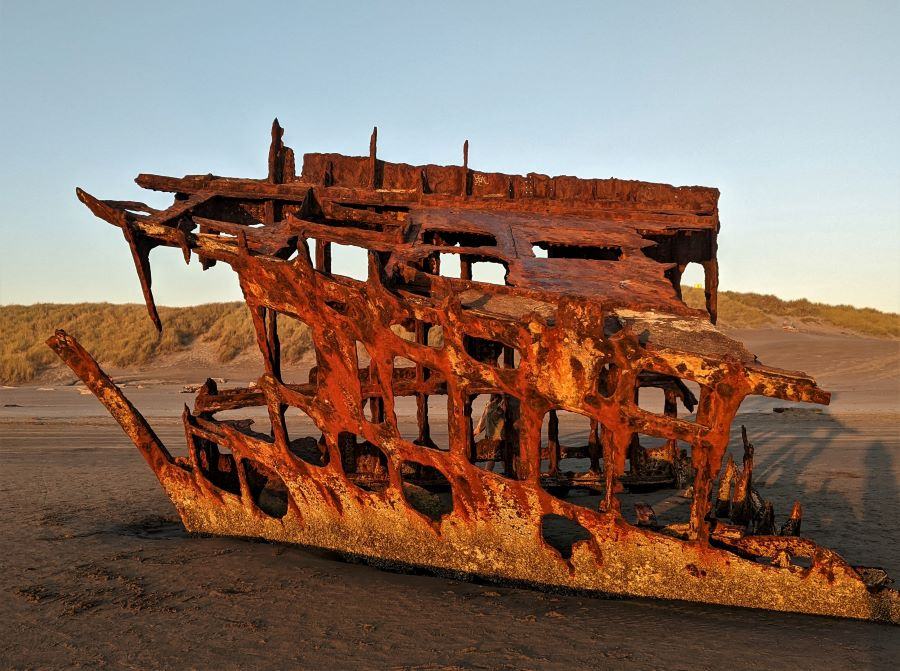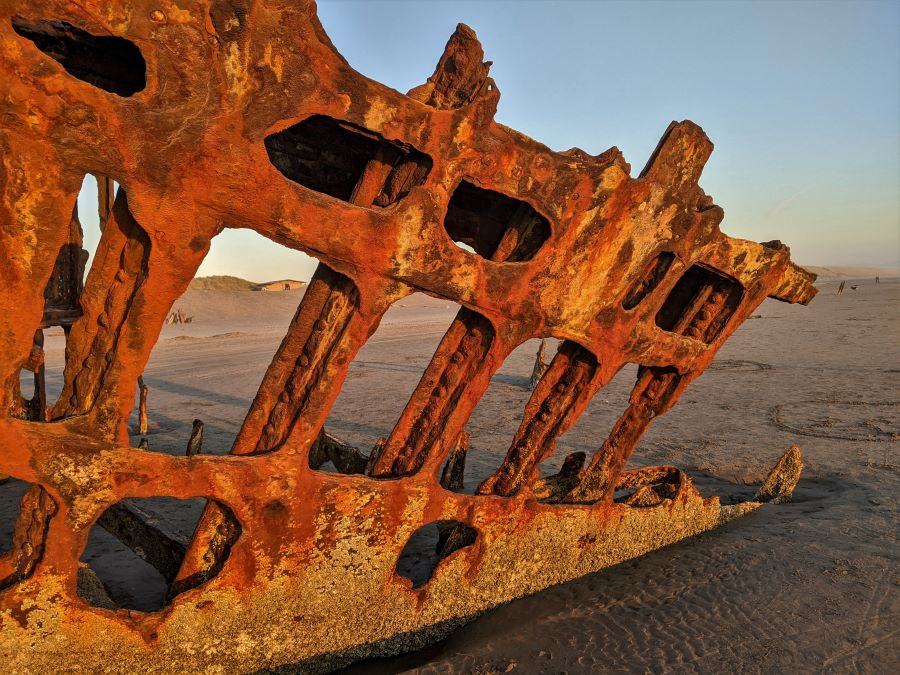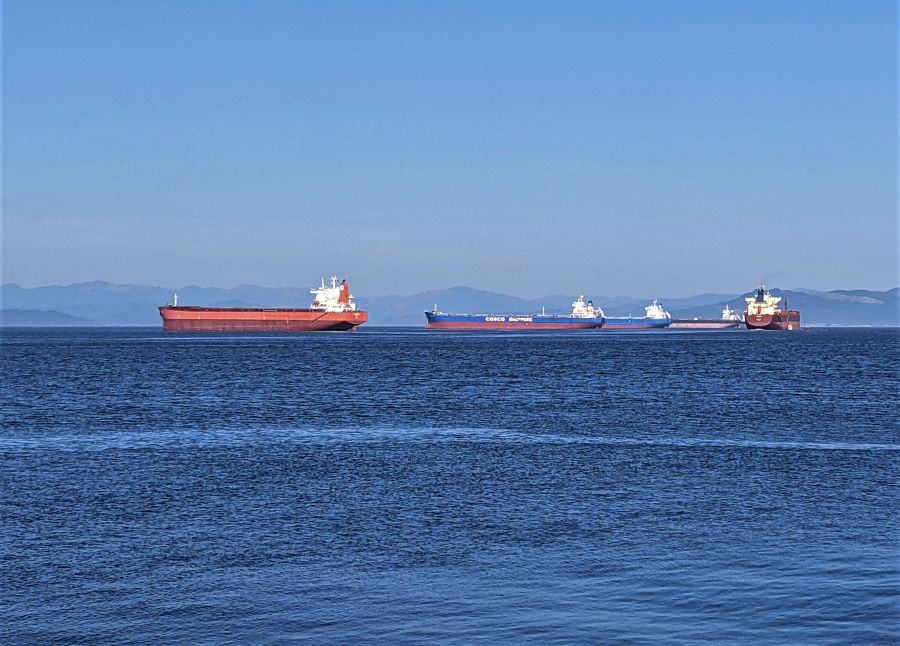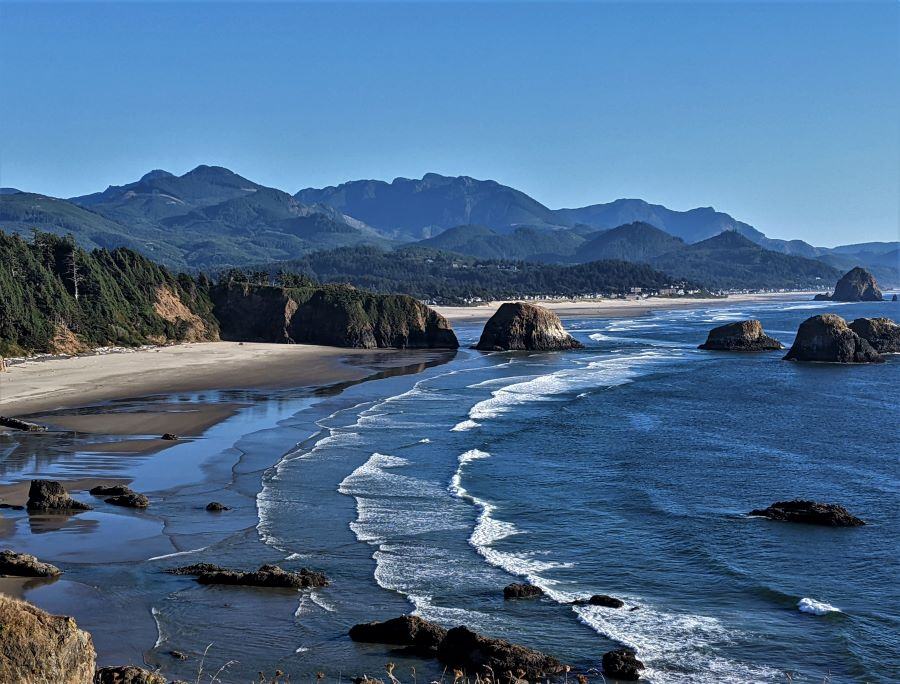Oregon was the only state in the United States directly attacked during World War II. The attack was at Fort Stevens. My bet is that you probably didn’t know this fact. Until our visit, I didn’t know it.
Hawaii and Alaska were not admitted to statehood until 1959 well after the war. Oregon however was a state when it was bombarded by a Japanese Submarine in June 1942. This was seven months after the Japanese attack at Pearl Harbor and right after the Japanese attack on Alaska.

Before this submarine attacked Fort Stevens it shelled the Estevan Point Lighthouse in British Columbia Canada and attacked a cargo ship off the coast of Washington. Later in the year, this same submarine launched a seaplane that dropped firebombs on the forest near Brookings Oregon. Then in November 1942, Japan attacked Oregon again by launching balloons carrying bombs. These balloons entered the jet stream and floated in the jet stream then dropped on the forest in Oregon hoping to start forest fires.
All of these attacks, especially the firebomb attacks were top secret. The United States didn’t want the Japanese to know that the attacks worked. During these three Oregon attacks, the only casualties were one family on a picnic in May of 1945. The children found one of the balloons in a tree and triggered the explosion killing six family members.
The picture at the top
The picture at the top of this blog post is the bow of the ship Peter Iredale which is beached on the shore at Fort Stevens. The Peter Iredale was a four-masted sailing ship that ran aground in 1906. This steel frame is the only remaining part of the ship. The wreck of the Peter Iredale is not associated with the World War II attack on Oregon.


The Columbia River
The Columbia River defines the northern border of Oregon. Fort Stevens is south of the Columbia River as it flows into the ocean.

The Columbia River creates a deep water shipping channel all the way to Kennewick Washington (probably beyond Kennewick, depending on who you ask). I sailed on a Navy ship up the Columbia River all the way to Portland. Recently, when we were paddling our kayaks in the Columbia River in Kennewick, we saw huge barges transporting grain on the Columbia River. The reason Fort Stevens was created was to control access to the Columbia River and all the points upstream.
Fort Columbia
Fort Columbia is situated atop Chinook Point on the north side of the Columbia River across from Fort Stevens. The two forts were built as coastal defense forts to control access to the Columbia River. Fort Columbia was built between 1896 and 1903. Fort Columbia is now a Washington State Historical Park.

Fort Stevens and Fort Columbia combine to control the entrance to the Columbia River the same way as Fort Worden, Fort Casey, and Fort Flagler combined to control the entrance to Puget Sound. Fort Stevens and Fort Columbia were part of the coastal defense fort systems and were similar to the ones discussed in this link. Fort Worden
Fort Stevens
Fort Stevens was the control point for all boat traffic moving up the river. The fort was built associated with the defense during World War I and two. Like other forts, we discussed along the west coast, the idea was that enough big guns would deter an attack. In most cases, this idea worked great. At Fort Stevens, the plan wasn’t foolproof.

Oregon Attacked at Fort Stevens
Notably, other than the Japanese attacks at Hawaii and Alaska, and the unmanned balloon fire bomb attacks by Japan in Washington and Oregon, one submarine carried out the only attacks by any nation on the mainland of the United States. The submarine followed fishing boats through the submarine nets and came to the surface in the Columbia River at nightfall. The submarine commander thought that they were attacking a submarine base. The first thing that Fort Stevens did after hearing the shells explode was to fire up their huge searchlights to try and spot the attacker.

At this point, I would love to tell you that the big guns at Fort Stevens did their job and put a quick end to the submarine. That, however, isn’t the way it played out. What happened (really this is the whole story) is the entire defensive action of Fort Stevens was to turn off the lights.
It was a night attack and by turning off the lights, the submarine no longer had any targets to shoot at and floated back down river and back out into the Pacific Ocean. Not a shot was fired at the submarine from Fort Stevens or any defensive position.

Lacking any targets to shoot at, the Japanese submarine quit shooting. Not one person was injured during the attack except for a slight injury to a soldier as he was running to his duty station. Later the submarine dodged some bombs dropped by an Army Air Corps aircraft.
Honestly, given the currents in the Columbia River, the Japanese submarine was lucky to escape without running aground during the middle of the night with almost nothing to look at. Once all the lights were turned off navigation back out the river mouth was probably as much luck as it was skill.
Our visit(s) to Tillamook Head and Fort Stevens
Our first visit to Tillamook Head and Fort Stevens was in the summer of 2018. During that year we canceled our trip exploring the Rocky Mountains in Montana because of too much smoke caused by wildfires. For us, going to the Oregon Coast was an escape route from the smoke.

2018 Running away from the smoke
In July 2018, the plan was to go to Idaho and Montana. This was a big year for forest fires and instead, while we were in the middle of Washington headed east we decided that the plan wasn’t going to work. Rather than going further east, we headed southwest. Our goal and hope were that we could escape the smoke that was blanketing the western states. Going southwest worked, once we got to Portland we had clear skies.

On Labor Day weekend we followed the Columbia River further west to Scappoose Bay. From Scappoose Bay, we took a day trip to Tillamook head and Fort Stevens. Here is a link to the story. Scappoose bay
2019 Southbound on the Oregon Coast
In 2019 we stayed in Fort Stevens and followed the coastline southbound from Fort Stevens seeing both Tillamook Head and Fort Stevens. While we were staying in Fort Stevens we had non-stop rain. Our introduction to fall on the Oregon coast was much as I expected, rain. Here is a link to our trip south, starting in Fort Stevens. Southbound on the Oregon Coast

This year’s visit to Tillamook Head and Fort Stevens
In 2022 we again wanted to see the Oregon coast and thus this story is about our visit to Fort Stevens as we were heading south again this time hugging the coastline in Olympic National Park. Here is a link to the previous place we stayed in Olympic National Park. Kalaloch Beach
What’s next?
It feels kind of funny approaching Christmas (in San Diego) and talking about our October visit to northern Oregon. Our travels have been so full of wonderful places and stories that it takes time to send our reports. I have to keep reminding myself that this is not a news blog, but rather a personal experience blog. This difference is that we are living the experiences (not just reporting on other people’s experiences) and we end up with lots of stories that we haven’t yet told.
So the answer to what is next is that we are continuing southbound and my next report will be about the only Naval Air Station in Oregon.
Please subscribe and join us on our journey
We will add you to our email list and send you updates about once a week. Here is a link. Subscribe
Links
Oregon Secretary of State Archives
National Park Service Fort Stevens
National Park Service Fort Columbia
Washington State Parks Fort Columbia


I am always surprised at how many places you discover and the stories you uncover. I never knew there were any attacks on any state during World War II.
Well, you can add me to the list of people who had no idea any of that happened. Wow. Talk about learning new things every day!
The wreckage of the Peter Iredale is always beautiful. I’ll never get tired of looking at the cool photos people take, and yours are no exception. Love the color and light.
And I’m with you on blog timing. These articles take a lot of time and it can be easy to fall behind (ask me how I know), but as long as it gets written at some point, assuming you’re still enjoying the writing process, who cares? They’re always fun to read – whenever they are ready.
Merry Christmas!
We have been full time traveling for two and a half years.
Went to Alaska this year and that was an adventure. We have been to 40 states and logged approximately 40,000 miles in our fifth wheel. Starting to slow down a bit now and stay longer when we can. Might get a seasonal spot next summer and a part-time job. I actually miss working.
How does a submarine in World War II launch a seaplane?
The seaplane was a Yokosuka E14Y. It was stored in a water-tight compartment and assembled before launch.
The submarine I-25 was the same one that attacked Fort Stevens. The raid was called the Lookout Air Raid and the target was to cause forest fires in Oregon north of Brookings.
This was the first time that the United States was bombed by an enemy aircraft.
Ooooh, Ooooh, I know I know!!!!
Naval Air Station Tillamook, is one of only three West Coast anti-submarine warfare / Coastal Patrol and defense Naval Air Bases dedicated to the care and feeding of the Navy’s blimp service.
I’ve flown from there extensively over the past 10 years. The airport manager there, George, is also a retired Naval Aviator, and the access road to the airport’s south entrance, Matlock Drive, where the FBO is located was posthumously renamed to honor an old friend, fellow tactical jet pilot and shipmate of mine, John Matlock.
John died tragically in a local demo flight when his L39 departed controlled flight at too low an altitude to effect a safe recovery or initiate a successful ejection.
The Erickson collection of WWII warbirds was housed there in the remaining blimp hangar before being moved up to Madras airfield where the environment was drier and the hangar was not made of wood.
Don’t forget about the US Naval Facility at Coos Head Oregon, it was an active SOSUS facility from the 1950s through the 1980s.
I was stationed there for 4 years providing the aviators with targets to prosecute.
I’ve been going to Fort Stevens camping in various modes for 53 years.
We hooked up with you guys in Sierra Vista when you still had the Open Road gasser.
I love the history that you tell in your stories. great blog!!
Kate and John